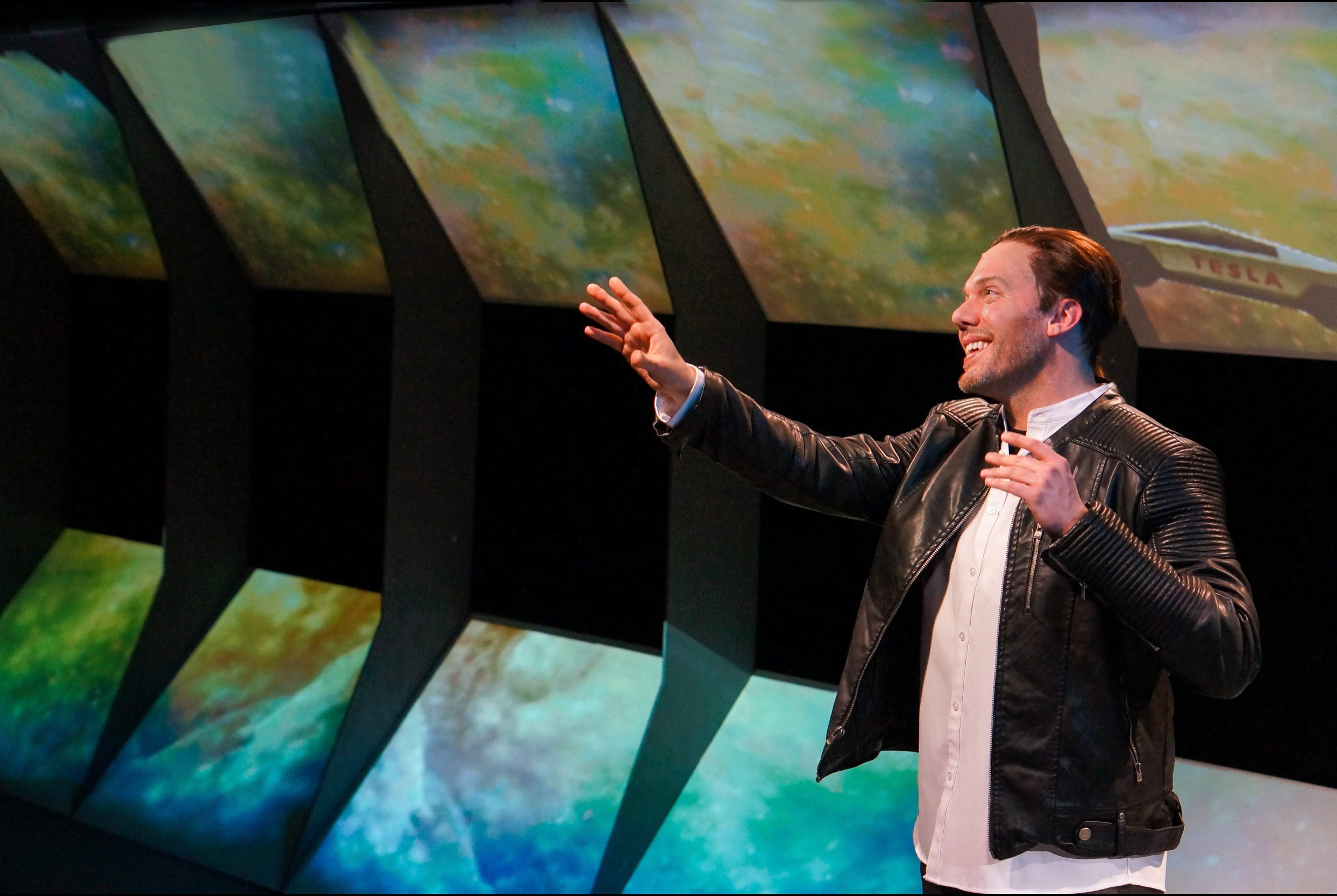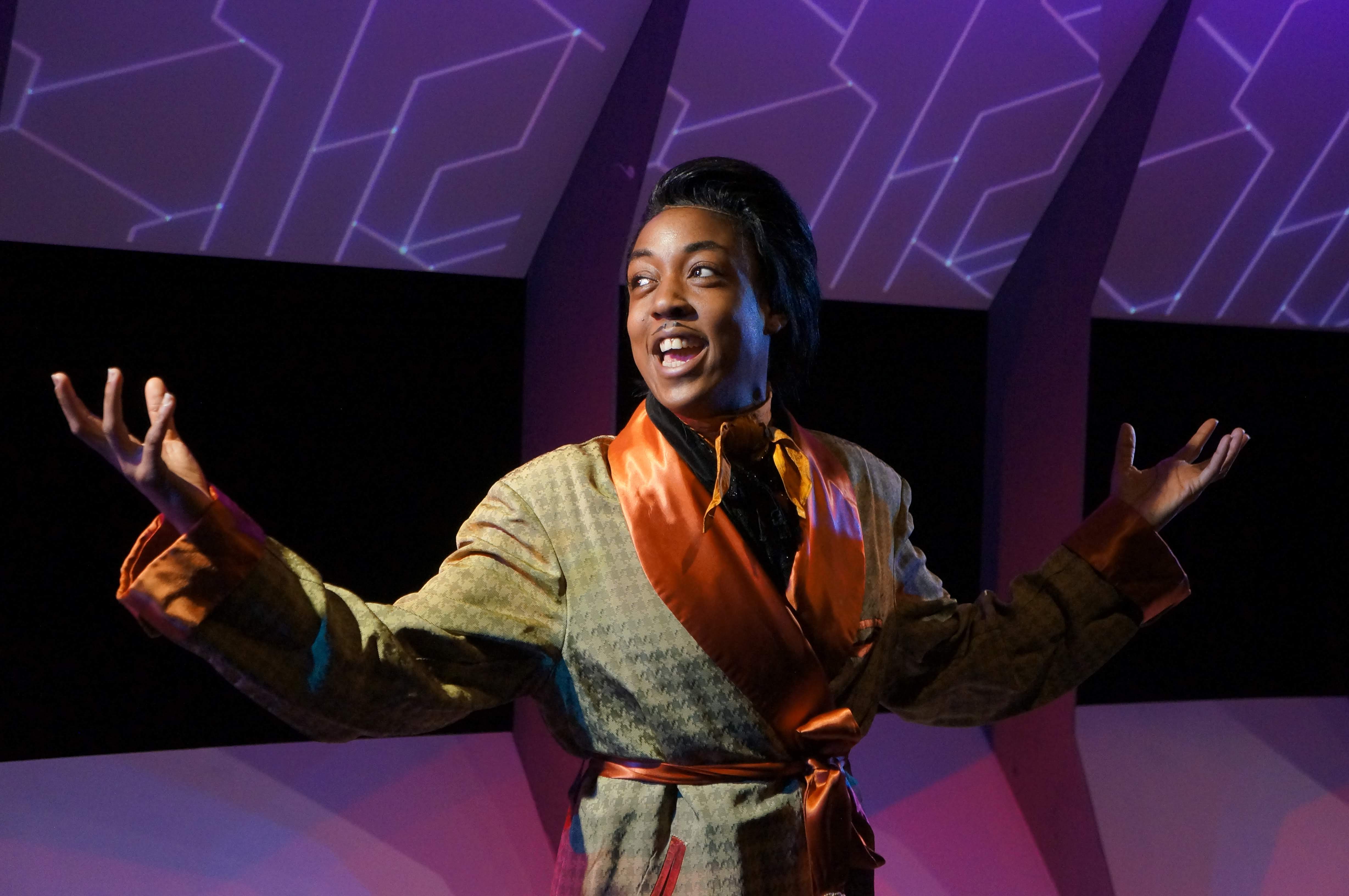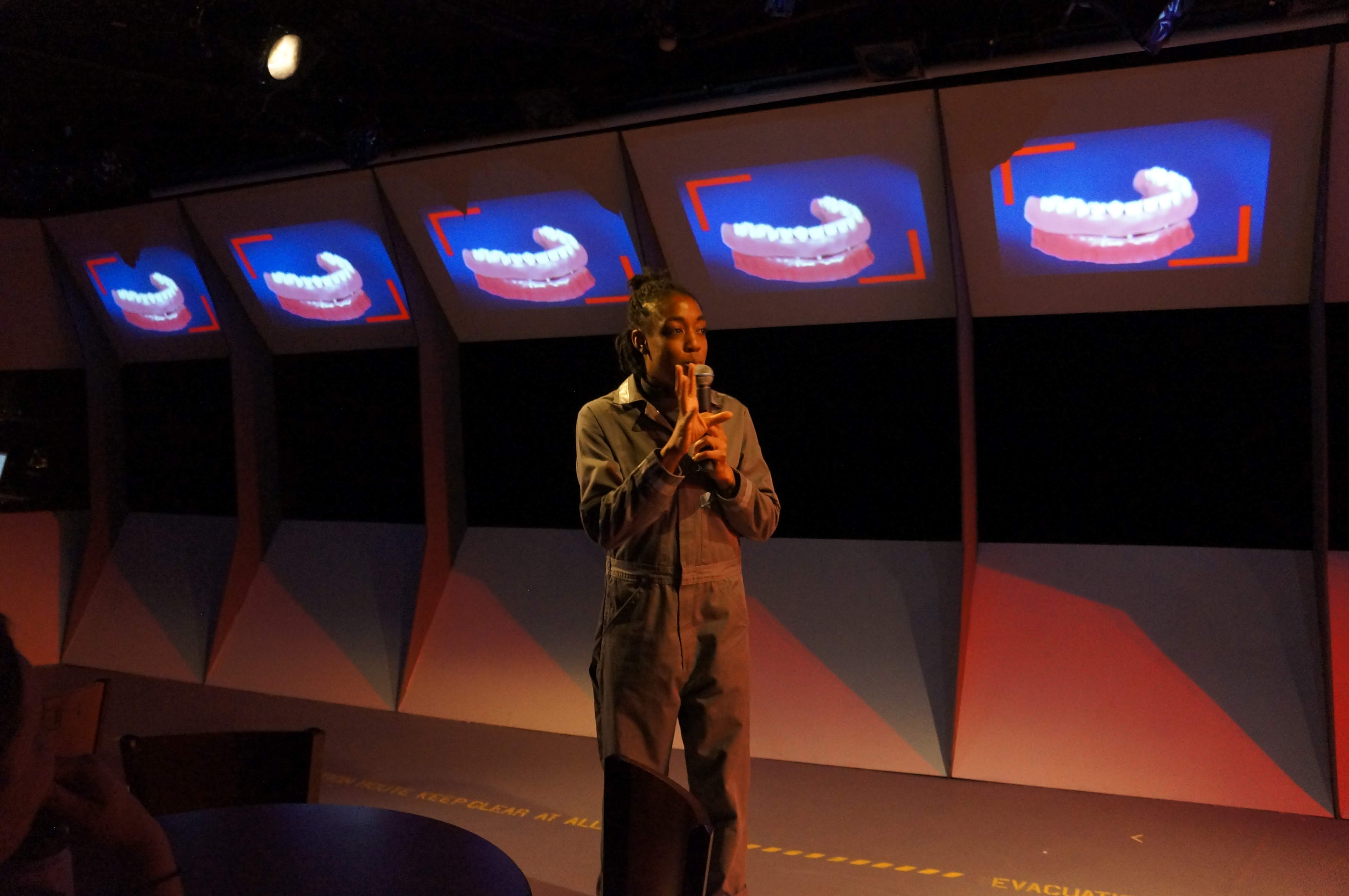︎Nuke Mars!︎Erin Sullivan in conversation with Liam Bellman-Sharpe︎Nuke Mars!︎Erin Sullivan in conversation with Liam Bellman-Sharpe︎Nuke Mars!︎Erin Sullivan in conversation with Liam Bellman-Sharpe

“All my life I have felt there is no place that’s just right for me here on the earth, that motivates the way I choose to use the bulk of my massive net worth.” David Mitsch stars as Elon Musk. Image by Linda Cristal-Young, 2020.
Nuke Mars!
Erin Sullivan in conversation with Liam Bellman-Sharpe
Erin Sullivan in conversation with Liam Bellman-Sharpe
In January 2020, Liam Bellman-Sharpe’s musical, Elon Musk and the Plan to Blow Up Mars, played at a sold out Yale Cabaret for three nights straight. The small venue was so packed that the show's crew had to cram between the wall and the risers to trigger lights, sound, and images from a pile of computers and cables. Erin Sullivan, the projection designer, tapped the spacebar on her laptop to fill the set’s backdrop with glowing galaxies. “We were inches away from people’s necks,” she says. “If an audience member leaned too far back, they would have bumped our small table and short-circuited the system.”
Such is the nature of the Yale Cabaret, or “The Cab”, as it is affectionately known. The twenty-seat dinner theater is the experimental playground of the students of Yale School of Drama and their collaborators, presenting over twenty shows a year. Productions are inherently low-fi, but highly innovative; in this case, Sullivan’s role was to balance those budgetary and technological restrictions with beautiful yet abstract machinations of sound, light, and texture. “The goal was never to create an authentically futuristic theater experience,” she explains. “I don't think there's any way to pull that off. The musical itself moves through genres and presents serious issues, but it’s very silly, and very fun.”
Sullivan graduated this year with an MFA in Design from YSD. Previously to that, she worked in New York as a film editor and in post-production. She was the Visual Effects Editor for The Marvelous Mrs. Maisel (Amazon Studios) and The Goldfinch (Warner Brothers). She produced and edited the stop-motion feature film In Reality, which won the Special Jury Award at the Los Angeles Film Festival. “I love the work,” she says. “The footage has been crafted by so many hands: director, writer, actors, cinematographer. And the editor gets to be alone with their ideas, sorting intention from possibility. It’s a voyeuristic puzzle. You get to slip through the story and discover its shape from the inside.”
When she wasn’t spending sixty hours a week in the darkness in front of her computer monitor, in her free time, she sought out real life experiences: movement, and dance. She began to play projection mapping; then she heard about the theater design program at Yale. “It was the perfect crossover of editing and spontaneity. I was curious about how you could use projections to tell stories. I loved the feeling of creating and committing to choices in the moment. There's no such thing as perfection. Theater is alive, which at first, felt terrifying. Post-production is about precision. Every frame of the film translates to digits and money. It can be very stifling,” she explains. “I’ve learned to let go of that, and this is what has been exciting to me.”
Sullivan and Bellman-Sharpe have worked on over a dozen projects together. “Liam was my closest collaborator during our time at Yale,” she says. “We share a mutual curiosity for the intersection of performance, sound, and video. For this show, there were other driving forces: science, slime molds, and the quandary of our ethical commitment to saving Earth at all costs.”
Liam Bellman-Sharpe is a composer and sound designer with an MFA in Sound Design from YSD. He creates sound and music for the collaborative arts. He specializes in devising unique musical and sonic scores and environments for theater, dance, installation, and hybrid forms, as well as designing sound delivery systems and software tools to realize these scores. He plays a variety of fretted and keyed instruments, and is a classically trained bass-baritone. He has taught actors to sing and play for many productions, and has performed a number of his own scores live, whether on established or invented instruments. He also holds a Bachelor of Music with Honors from the Melbourne Conservatorium of Music. As a composer, sound designer, orchestrator, and music director, his work has been heard in the United States, Europe, Hong Kong, and Australia.
Elon Musk and the Plan to Blow up Mars: The Musical was his Yale thesis project, prompted by a simple, enigmatic tweet published by Musk on August 15, 2019: “Nuke Mars!”. This led Bellman-Sharpe to explore the question: If we think that we can settle Mars, does that stop us from taking care of Earth?
—Alex Zafiris

“The ice caps are melting, the oceans are rising, we’ll soon be underwater. I bid goodbye to my dreams of a little son or daughter.”
Maal Imani performs as “Daddy”. Image by Linda Cristal-Young, 2020.
Maal Imani performs as “Daddy”. Image by Linda Cristal-Young, 2020.
Erin Sullivan: So, there is a lot going on in the show—it questions corporate greed, global warming; there's a tragic love affair between a space cadet and an anti-matter being. Can you talk about the primary seed of its conception?
Liam Bellman-Sharpe: I came to learn a lot about Elon while writing the show, but I didn't actually know that much about him before having the idea. For whatever reason, I went on this really long Wikipedia rabbit hole around two main tracks: Different religious theories about how the world and the universe ends, and then different scientific theories about how the world and the universe ends. Somewhere along the way I wondered, how does a person’s belief in an afterlife affect their moral compass, how they act, and influence how they should lead their life in this immediate, concrete world? Do they even think that there is something after this life? The next step from that was: Is there a sense in which a belief in post-Earth human society is affecting people's sense of environmental ethics? And the next leap from that was, I should write a musical about Elon Musk, destroying Mars to save the Earth. As in: Elon Musk realizing that runaway global warming and inaction around global climate change is a tacit, or unconscious comfort that people have, like the idea of settling on Mars. What if he realizes that he has to destroy Mars to wake people up to the need to save the Earth?
ES: Why a musical?
LBS: The idea of it being an ‘anti-musical musical’ was fundamental to the piece’s DNA. I believe that musical theater as a genre transmits the belief that the world is fundamentally good, that redemption is possible, and that things will all be alright. There are of course exceptions to this, but overwhelmingly, musicals tend to be optimistic, nostalgic, or both. For a show about the end of the world, nostalgia and optimism did not seem possible, let alone appropriate.
ES: So, you set out to write this musical… and ended up writing, producing, and composing music for the show... and you were also the director and sound designer. How did that go?
LBS: I don't recommend it! Initially, I didn't plan on directing it myself. I had directed a little bit before, in my undergrad. I had some residual sense of how to go about it. I just felt maybe it was better for me to do it. Maybe I could have brought someone else on that would have involved me backseat-directing, trying to translate ideas through them. In the end, it was doing all of those things that was pretty stressful, because I was music directing as well. I think that, you know, if I just had one less thing, it would've been preferable. For better or worse, I had a lot of creative control.
︎The idea of it being an
“anti-musical musical” was fundamental to the piece’s DNA.
ES: Being a director, you have to ensure the cohesion for all of the design elements of the show, such as the set design, costumes, lights, and projections. Can you talk a bit about that process?
LBS: The thing that I've always enjoyed the most about working in theater and collaborating is being able to bounce ideas off people. Certainly, one of the most satisfying parts of this process was those creative conversations with the design team, the technical team, and with the actors in the rehearsal room, in the vein of: Here is this script I've written, and here are some ideas I have about it. Each of the designers is an expert in their field. All the actors are brilliant performers. Even though they're students, they really are at an incredible standard. They have responses to me having an aesthetic reference from a weird sci-fi film. I think in terms of cohesion, it came from just a lot of conversations. One of the great things about working from source material that involves a real person or a real company is that you have facts to go on. Our costumes could be inspired by the SpaceX attire. Our set could be inspired by actual renderings of SpaceX spaceships. And of course, there were departures from these things. I think we were able to find a mix of pop culture references, like satire of real things, or just weird in-jokes that the audience wouldn't necessarily get, but were there for us. I think we were able to find a common language.

“We’re born on different sides of a cosmic divide, it would be suicide if our bodies collide, but I couldn’t forget your face if I tried.”
Two star-crossed lovers, Space Cadet and Anti-Matter, played by Madeline Seidman and Patrick Young. Image by Linda Cristal-Young, 2020.
Two star-crossed lovers, Space Cadet and Anti-Matter, played by Madeline Seidman and Patrick Young. Image by Linda Cristal-Young, 2020.
ES: How important was it for the audience to believe that it's a spaceship, or was it not important at all? What specific details did you need to get right, and which others were just farce or comedy?
LBS: In early conversations with Alex, our set designer, we both wanted to try and do something that we had never seen at the Cab before. One of the ways of this approach was using a main reference image: The famous 2001: A Space Odyssey shot of an octagonal corridor with the man in the spacesuit walking down it. This was a repeated, very geometric architecture visual. We did these octagon sections, that had angled panels at the ceiling and the floor, with a blank space behind them, which opened up the area for the wonderful projections. It had to be something that could suggest a spaceship very strongly but could also disappear and become something else. With the aids of sonic and video transitions… it could become a screen or an ocean, or a car, and do it super quickly.
ES: You did quite a bit of research to get the science rhetoric right.
LBS: The show is a comedy, and is really silly, but still talks about serious things. I don't feel like it would have been funny if I had just made up the science.
ES: Because star-crossed lovers of anti-matter are definitely not made up!
LBS: Well that was made up! But it couldn't start with a made-up thing. It felt important, also, to make sure that it was something an audience could follow logically. Comedy has a different texture, when it's fact-based. And: Learning all the details, technical equations, and formulas that are involved in high-level rocket science or physics—or chemistry or any kind of science—is incredibly impressive. And then, to be able to master that information, and wield it.
ES: Are you a master now?
LBS: No, no, not at all! But I think I achieved an understanding of the basic principles involved, that I feel is accessible to most people with sufficient time and interest. I will probably never be a rocket scientist, but a very dense weekend of Wikipedia allowed me to learn about rocket science and rocket propulsion enough to write comedy about it. The idea of all the characters feeling very comfortable in that science was important to me. I think knowledge is cool.
ES: And was Elon comfortable? Not the real Elon, but the Elon character; played hilariously by David Mitsch, who was also the costume designer, while starring as Elon and learning song and dance for the show along with all the scientific rhetoric.
LBS: David is an absolute hero. I initially approached him when I was putting the team together. I had seen his work as a costume designer and performer before, and really loved it. I said, Look, I would love to have you involved in either of these capacities, whichever seems more interesting to you. And he said, Well, why not both? We may have been a little tipsy. But he came on board and did this incredible job. You can learn something about rocket science in a weekend when you're memorizing a whole bunch of lines and songs, and doing costumes for a musical, which you're also starring in; you don't have time to learn rocket science. I watched him come to an understanding of all the logical and technical progressions required to communicate the scene, do all this work in rehearsals, and then get in front of an audience. He took this text I'd written, and transformed it into something so totally his own. It was super wonderful to see.
ES: He portrayed Elon as a bit of a sweet-hearted doofus, compared to the more evil caricatures of the other titans, like Jeff Bezos, played by Eli Pauley. Are you making a commentary on the spectrum of evil within the league of the world’s billionaires?
LBS: Elon starts as a sweet-hearted doofus. I wouldn't say he stays that way. The reason that we first encounter Elon as this hopeful Disney Prince is because audiences know what that kind of character feels like. The second number of the show is this solo song. Elon's on stage by himself, singing,
All my life
I’ve felt there is no place that's just right for me here on the Earth
That motivates the way I choose to use the bulk of my massive net worth
I’ve felt there is no place that's just right for me here on the Earth
That motivates the way I choose to use the bulk of my massive net worth
That’s such an efficient way of on-boarding an audience to this show, and getting them invested in Elon's desire to reach for Mars. Of course, that is subverted very quickly in the next song. It doesn't say a lot politically, but Elon does become a villain, but in a way that the audience is able to track intuitively, if not always logically, because of these little tidbits of genre. We pivot from Disney Prince to a Jesus Christ Superstar rock anthem to Star Trek space scenes, film noir, and shady outer space. And all of a sudden, Elon has gone from being an optimistic dreamer, to an idealistic radical, to a scheming villain. As disjointed as things may seem, all of this is in there for a reason.

“This is a thought experiment. It involves corporations and sufficient time.”
Maal Imani as “Daddy.” Image by Linda Cristal-Young, 2020.
The piece then shifts, and becomes like an educational children's show with a song about slime molds, which are these creatures that are somewhere between bacteria and fungi. They live mostly as single cell organisms, but certain species of them—when resources become scarce—can clump together. They live as this sort of plasmonic mass, and they can totally dissolve their individual cell membranes and become just one big cell. Are these organisms working together, to exhibit these incredibly complex behaviors—which are very close to intelligence, in spite of having no brain and no neurons?
︎Elon starts as a sweet-hearted doofus. I wouldn't say
he stays that way.
Prior to this song, there is a debate: does Elon have authority because he's funded the space ship and has all the money? Does the captain of the ship have authority based on positional power? Do the crew have authority if they vote for an outcome? Is that outcome invested with legitimacy by virtue of all of them agreeing to it? Will change be wrought by heroic individual action, or by collective effort?

Lighting Designer: Noel Nichols
Sound System Designer: James T. McLoughlin
Projections Designer: Erin Sullivan
Associate Projections Designer: Hannah Tran
Associate Stage Manager: Kevin Jinghong Zhu
Dramaturg: Henriette Rietveld
Technical Director: Jonathan Jolly
Producer: Carl Holvick
Sound System Designer: James T. McLoughlin
Projections Designer: Erin Sullivan
Associate Projections Designer: Hannah Tran
Associate Stage Manager: Kevin Jinghong Zhu
Dramaturg: Henriette Rietveld
Technical Director: Jonathan Jolly
Producer: Carl Holvick
Stage Manager: Sam Tirrell
Cast: Patrick Ball, Patrick Falcon, David Mitsch, Eli Pauley, Madeline Seidman, Nomè SiDone, Bailey Trierweiler, Maal Imani West, Isuri Wijesundara, Patrick Young
Musicians: Sharon Ahn, keyboards; Roberto Granados, guitar (alternate); Thomas Hagen, drums; Satchel Henneman, guitar; Taylor Hoffman, vocals; Paul Mortilla, violin; Adin Ring, bass
Poster by Devin Matlock
Cast: Patrick Ball, Patrick Falcon, David Mitsch, Eli Pauley, Madeline Seidman, Nomè SiDone, Bailey Trierweiler, Maal Imani West, Isuri Wijesundara, Patrick Young
Musicians: Sharon Ahn, keyboards; Roberto Granados, guitar (alternate); Thomas Hagen, drums; Satchel Henneman, guitar; Taylor Hoffman, vocals; Paul Mortilla, violin; Adin Ring, bass
Poster by Devin Matlock